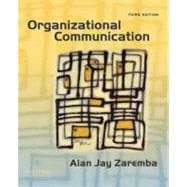
Note: Supplemental materials are not guaranteed with Rental or Used book purchases.
Purchase Benefits
What is included with this book?
| Preface | |
| Foundations | |
| Organizational Communication: An Introduction | |
| Communicating with Chuck | |
| Communication and Organizational Success | |
| Communication is Central | |
| Communication is a Pervasive Activity | |
| Organizational Communication is Multidimensional | |
| Misconceptions about Organizational Communication | |
| Defining Terms | |
| Defining Factors: Skill, Networks, Culture, and Power | |
| Text Features | |
| Practitioner Perspective: Craig Ingraham, Vice President and Senior Counsel | |
| Management Theory and Organizational Communication | |
| Communicating to a New Staff | |
| Demystifying Theories | |
| Symbiotic Theory: What is Symbiosis and Symbiotic Theory? | |
| Classical Theory of Management | |
| The Hawthorne Studies | |
| Theory X and Theory Y | |
| Practitioner Perspective: Duane Vild, Complex Warden for State of Arizona Department of Corrections | |
| Bureau Administrator, Department of Corrections | |
| Theoretical Foundations: Systems, Culture, and Power | |
| Sales Department, Service Department, and Customers Background | |
| Systems Theory | |
| Cultural Theory | |
| Critical Theory | |
| Applying Symbiotic Theory | |
| Practitioner Perspective: Robert Peterkin, Former School Superintendent | |
| Ethics and Organizational Communication | |
| Lying to Rachel Adams | |
| Examining Ethics | |
| Ethical Decisions and Organizational Communication | |
| Is Honesty Overrated? | |
| The Normalization of Deviance | |
| Moral Conflict | |
| Strategic Ambiguity | |
| Assessing Attitudes toward Ethical Communication | |
| Making Ethical Decisions | |
| Practitioner Perspective: Victoria Kohlasch, Managing Director of Marketing | |
| COMMUNICATION IN A COMPLEX SYSTEM | |
| Managing Information | |
| Communicating Tasks, Policy, Recognition, and Culture | |
| Information and Organizations | |
| Selecting Media Options | |
| Social Media | |
| Knowledge Management | |
| Human Needs: The Human Moment | |
| Information Needs and Selecting Media: A Recap | |
| Practitioner Perspective: Gordon Rudow, CEO | |
| Communication Networks | |
| Internet Development, CCS, and Customers | |
| What are Communication Networks? | |
| Types of Communication Networks | |
| Location: External and Internal networks | |
| Formality: Formal and Informal networks | |
| Direction: Upward, Downward and Horizontal networks | |
| Practitioner Perspective: Mike Armani, Vice President for Marketing and Communication | |
| Culture, Climate, and Organizational Communication | |
| The Elan Corporation | |
| Climate and Culture | |
| Organizational Culture | |
| Relationship between Climate and Culture | |
| Culture, Communication, and Assimilation | |
| Leadership | |
| Emotional Intelligence | |
| Conclusion: Credibility and Human Values | |
| Practitioner Perspective: Governor Michael Dukakis | |
| Meetings and Teams: Conflicts and Interventions | |
| Gerald Sweeney and the Regular Wednesday Meetings | |
| The Phenomenon of Meetings | |
| Primary and Secondary Tension | |
| Counterproductive Group Tendencies | |
| Interventions | |
| Making Interventions Work | |
| Practitioner Perspective: Gail Hunter, Vice President in Events and Attractions, National Basketball Association | |
| CONTEMPORARY ISSUES | |
| Intercultural Communication and the Organization | |
| Rando Systems Expands Internationally | |
| Why Study Intercultural Communication? | |
| What Do We Mean by Culture? | |
| Intercultural Communication in Organizational Contexts | |
| Practitioner Perspective: Steve MacLeod, Senior Vice President | |
| Crisis Communication | |
| The Nuance Group | |
| Organizations and Crisis Communication | |
| Crisis Communication Planning | |
| Proactive Crisis Communication | |
| Steps to Crisis Communication Planning | |
| Image Restoration Theory | |
| Recurring Counsel for Crisis Communicators | |
| Practitioner Perspective: Jason Vines, Vice President for Communication | |
| Assessing Organizational Communication Quality | |
| STIG: Perspectives of a Staffer | |
| What is a Communication Audit? | |
| Audit Qualities and Components | |
| Reporting Results | |
| Practitioner Perspective: Angela Sinickas, Founder and President | |
| Careers in Organizational Communication | |
| What Can I Do With This? | |
| Communication as Critical to Success | |
| What Jobs Are Available? | |
| Preparing for the Job Market | |
| Practitioner Perspective: Marcia Meislin: Owner | |
| Notes | |
| Credits | |
| Index | |
| Table of Contents provided by Publisher. All Rights Reserved. |
The New copy of this book will include any supplemental materials advertised. Please check the title of the book to determine if it should include any access cards, study guides, lab manuals, CDs, etc.
The Used, Rental and eBook copies of this book are not guaranteed to include any supplemental materials. Typically, only the book itself is included. This is true even if the title states it includes any access cards, study guides, lab manuals, CDs, etc.